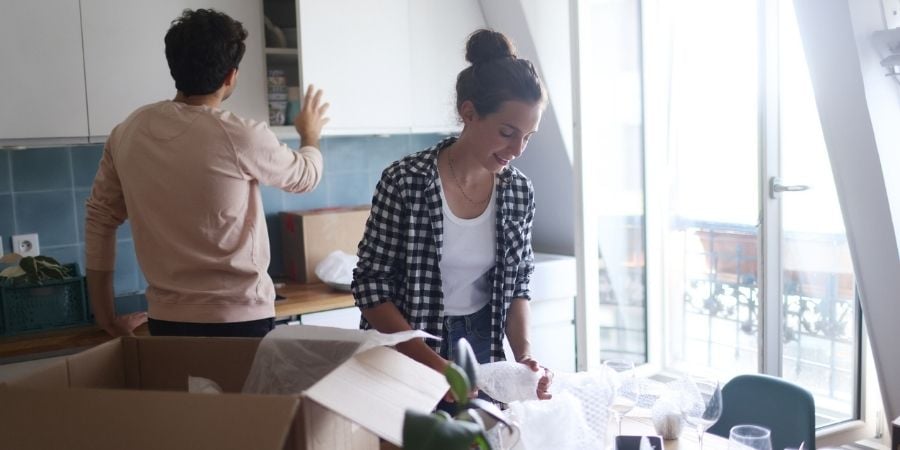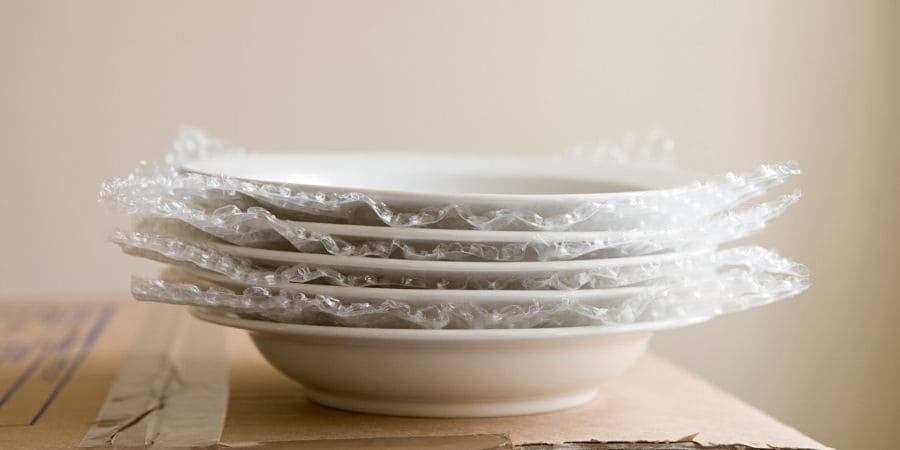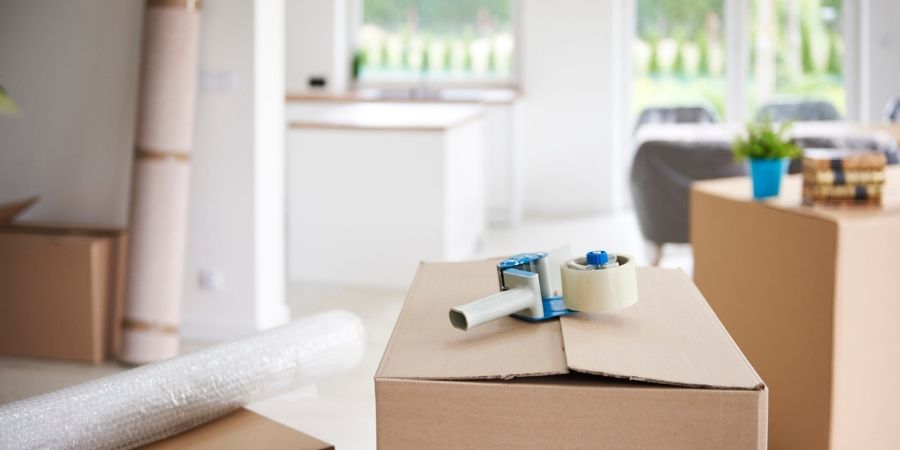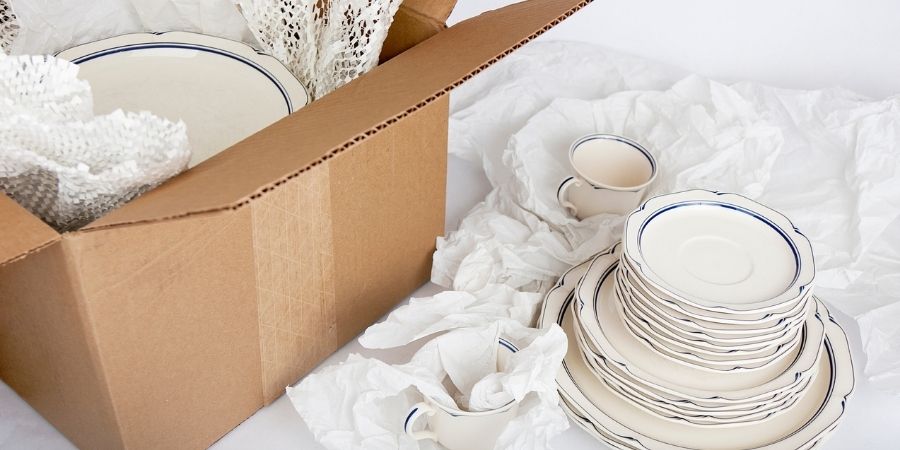So, you’ve secured a moving company and now it’s time to start packing your belongings.
Packing plates and other dishes may take you longer because of their fragile nature, but you’ll want to make sure that you’ve done it correctly, so everything arrives at your new home safe and sound.
Did you know that you should pack plates vertically? We’ll go over the specifics of packing plates, glasses and other dishes in this step-by-step guide.
What supplies do you need to pack dishes?
The moving supplies you’ll need are different for everyone, but we’ve compiled a list of some general suggestions that you should have on hand.
While newspaper is a viable option, it’s important to note that it is often thin, and ink may transfer onto your glasses, so it may be better as a cushioning material.
Packing dishes checklist:
Packing tape.
Moving boxes; it’s best to have a variety of sizes so you can group like items together and avoid overpacking.
Something to secure boxes, like rope, bungee cords, etc.
Labels or colorful markers to help label each container.
Packing paper, newspaper, foam or bubble wrap.
Additional items for cushioning, like packing peanuts, more crumpled packing paper, dish towels or air pillows/air bags
| How to choose the right packing materials for plates and glasses? | |
| What is it? | What should you use it for? |
| Packing paper | Wrapping any dishes, glassware or silverware; filling gaps inside boxes |
| Packing peanuts/foam peanuts | Filling the gaps inside boxes to help prevent items from shifting |
| Bubble wrap | Wrapping any dishes or glassware |
| Packing foam | Delicate dishes (e.g., fine china, wine glasses); layering on the bottom and top of boxes |
| Newspaper | Wrapping any dishes, glassware or silverware; filling gaps inside boxes; newspaper ink may transfer onto your glasses or plates, so use with caution |
| Air bags or air pillows | Filling gaps inside packages boxes, adding additional layers of protection on the sides of boxes or between particularly delicate items |
| Glassware divider set | Any type of glasses, from wine glasses to mason jars |
| Shredded paper | Use in place of, or in addition, to packing peanuts for filling gaps and empty spaces in boxes |
| Linens or towels, e.g., kitchen towels, aprons, beach towels, pillowcases | Wrapping various items, especially if you want to have fewer boxes when you move; for cushioning the tops and sides of boxes |


How to pack dishes, plates and glasses for moving
The kitchen can be a difficult room to pack when you’re moving. It’s filled with delicate items and electronics you’ll use until the day of the move. Because of that, it’s often the last room you’ll pack and the first you’ll unpack when you get to your new home.
In this next section, we’ll go over how to best pack these fragile items so they arrive safely at your new home.
What is the best way to pack plates?
Now that you've got your moving boxes, we’ll go over a way to help prevent your dishes from breaking using packing paper. This paper is an excellent thing to use because it’s often affordable and easy to recycle when you’re done moving.
First thing’s first. You’ll want to add a layer for cushioning at the bottom, before adding any dishes.
You can use a towel, crumpled packing paper, bubble wrap or other linens. Anything soft that will help absorb any bumps or jostling that might occur in the moving van on the way to your new home.
We recommend using packing paper about 3-4 times the size of the dish.
Lay several layers of the paper on a flat surface. (For thinner or more delicate dishes, you should use more paper.)
Place the first dish in the center of the paper, then fold all sides in, completely wrapping the plate. Tape down any loose ends.
Repeat until every item is wrapped.
Turn the plates vertically and place them inside the box.
Repeat these steps until the box is full. Make sure you don’t overpack. Leave enough space at the top to fill with extra linens or crumpled paper to prevent the dishes from shifting.
Mark the box as delicate.
If you have smaller pieces of newspaper or packing paper, follow the steps above until step three.
Instead of folding one corner over, place several layers of the packing material over each plate until you’ve got four neatly stacked.
Once you’re done with the set, wrap the entire set in a longer piece of paper or towel until it’s snug. Turn the plates vertically and add them to your box, repeating this method until it’s is full.
Once full, you’ll follow the above steps to fill with cushioning.


How do you pack dishes for moving with bubble wrap?
The bubble wrap method is similar to the above directions. It’s best to use rolls of bubble wrap for this method, but you can also use recycled or discarded bubble wrap from packages. You’ll just want to make sure your bubble wrap successfully covers the dish.
Fill the bottom of your packing box with crumpled paper, linens or several layers of bubble wrap. Make sure to place bubble wrap so the air-filled bubbles are facing up, towards the dish.
Stack one place setting within easy reach, then grab the first dish and place it in the center.
For small sheets: Sandwich in-between each plate.
For a roll of bubble wrap: Unroll it, then put the plate on top. Bring the roll up and over the plate. Add a second plate, then repeat with the other dishes.
Once you have your set of plates layered with bubble wrap, tear the perforated edges or use scissors to cut it.
Tape any loose edges down, over the dish.
Unroll and cut an additional layer of bubble wrap, if desired, and cover your fragile items for extra protection.
You’ll turn these plates sideways and place them inside the cushioned box.
Once done, fill any remaining holes with more cushioning.
Place a final layer of bubble wrap, or other soft material, inside the top of the container for added protection.
Make sure not to overpack!
Label box as delicate.
Five bonus tips for packing dishes:
Ensure that every box has a layer of cushioning on the bottom and top.
Consider using smaller containers with extra cushioning for vintage dishes or more fragile pieces of china.
If you’re using a box with different kinds of dishes, pack the plates vertically on the outside and the heavier dishes (like glass pie plates or other ovenware) in the middle. This helps distribute weight and minimize breakage during the move.
Consider purchasing studier plastic boxes or dish boxes. A dish box has an additional layer of cardboard, so they are sturdier than regular corrugated cardboard boxes.
Don’t forget to label fragile boxes so extra care will be taken when moving.


How to pack bowls for moving
If you’re ready to wrap your bowls, we recommend packing paper or bubble wrap. The packing material should be large enough to cover each bowl twice.
Layer the bottom of the box with your chosen packing materials until there are several inches of cushioning.
Lay several layers of the packing paper or bubble wrap on a flat surface.
Place the first bowl in the center of the paper, then grab one corner of the paper and fold it over and into the bowl, crumpling up the edges. Grab two of the other ends and fold each one over and into the bowl, tucking the corners into the center.
You should have one final edge that you haven’t wrapped into the center of the bowl. Now, you’ll grab the bowl and fold it towards the last edge, wrapping any spare paper tightly inside the bowl.
Tape off any loose edges, then repeat with the rest of the bowls in your tableware set.
Turn the bowls on their sides and nestle each one into the cushioned box.
Once the box is almost full—but not too full—fill any gaps with crushed paper or linens, then add a final layer of cushioning on the top.
Mark box as fragile.
Other tips for packing your glassware:
Pack glasses standing up, how you would store them in the cabinet.
Try to group similarly sized and shaped glasses together to save space.
If you’re doing a double layer of glasses, you’ll want to pack the heavier, larger ones first, on the bottom of the container.
Think stein glasses, large tumblers and carafes.
If you want added protection, consider placing the most fragile items in a single layer in a small or medium box with extra packing materials for cushioning.
This could include delicate stemware, porcelain cups, teacups or sake cups.


When should you start packing your dishes for moving?
The kitchen is usually one of the last rooms you’ll pack during a move, but that doesn’t mean you can’t be preemptive and fill a few boxes early.
Pro-tip: We recommend packing seasonal and infrequently used containers at least one month before your move.
As you get closer to the move, it’s a good idea to pack up the other dishes, keeping one or two boxes with the essentials.
Pack your fine dining table sets and nice china first, unless you know you’ll be hosting a dinner party before your move. (Don’t forget to mark the boxes as fragile.)
Pack seasonal cooking items, like turkey pans, barbecue or grilling equipment and infrequently used utensils and glasses.
Pack special occasion baking items like cake stands.
Extra towels and linens make great padding!
You should leave out kitchen essentials. These differ for everyone but may include:
One of each per person: plate, bowl and cup or mug.
Complete set of flatware for each person (a spoon, fork, knife).
Kitchen utensils, like spatulas, wooden spoons, a peeler and tongs.
Baking and cooking utensils, like measuring cups and spoons, cooking thermometer, whisk and mixing bowls.
A chef’s knife, paring knife, serrated knife and cutting board.
A 12” all-purpose skillet or frying pan and at least one medium-sized pot with a lid.


Top hacks for packing dishes:
We hope these packing tips will help make your next attempt at packing dishes much easier and smoother. We’ve compiled a few of our favorite tips here:
If you don’t have any air bags or air pillows, consider partially inflating balloons to use as cushioning in boxes.
Save package delivery boxes and envelopes. Many of these items come lined in bubble wrap or other cushioning materials you can reuse. In a pinch, padded envelopes make an excellent wrapper for fragile items.
Avoid overfilling your boxes, as overstuffed boxes are more susceptible to damage during the move.
If you have limited space in your moving truck, wrap dishes in linens, pillowcases, shirts or other clothes.
Always pack heavier dishes in the bottom of the box and lighter dishes on top.
Last-Minute Moving Day Packing Tips
Sometimes you need to pack your belongings quickly. If that’s the case, there are still ways to help make sure your dishes get to their destination in one piece.
Here are a few of our favorite last-minute packing tips:
Socks are a great option for packing many types of glasses, from shot glasses or tiny teacups to wine glasses.
Place a glass inside the sock, then roll the open hole over the glass.
If you’re lacking in moving supplies come moving day, a styrofoam plate or bowl makes excellent cushioning material for plates and bowls.
To use, layer the foam plates in-between each dish.
Have you already packed your linens and towels? Plastic cling wrap can serve as a buffer in a pinch for tightly wrapping cutlery or utensils.
Heavy-duty shrinkwrap is an all-purpose item you can use to wrap all manner of things. Use it to completely wrap boxes if you run out of tape, or wrap two small boxes together to keep them grouped during the move.
A security system from ADT can help keep all your valuables safe.
Now that you’ve moved to your new place, it’s a great time to consider upgrading your home security system. ADT has everything you need to help keep an eye on your property, from video doorbells and outdoor cameras to pet-friendly motion sensors.
Frequently Asked Questions about How to Pack Plates and Dishes
What order should you pack your dishes in when moving?
We recommend packing like items when at all possible, but if you don’t have enough space to do this, you should add heavier items to the bottom and middle of the box and lighter items on top and on the sides.
For example, add heavy serving dishes to the center of a box and plates on the outside. Or add plates and bowls on the outside and mugs on the inside. Or, if you are packing like items together, make sure your heavy steins are in the middle and your mugs are on the outside of the box.
How many boxes do I need to pack up my kitchen?
For larger kitchens for people that tend to cook more, it’s a good rule of thumb to have a mix of 15-20 medium and small boxes and at least 1-2 large boxes for lightweight linens. If you don’t cook much, or have more restricted kitchen space, 10-15 medium and large boxes should suffice.
T-shirts, skirts, leggings and other linens like dish or beach towels make a great alternative to paper materials. Stuff socks or tights inside mugs or cups, then wrap them in a t-shirt. Wrap a glass casserole dish in a large shirt or dress.
If you have any foam plates or bowls, they can also serve as padding between their glass counterparts.
Since most moving boxes are recyclable, you should avoid throwing them away and consider giving them to someone else who might find them helpful.
Should you pack dishes vertically or horizontally?
It’s best to pack dishes vertically as if you were loading a dishwasher. This helps prevent breakage by keeping pressure off the plates being stacked one on top of the other. Additionally, if plates are jostled during the move, it’s more likely that only a few will break instead of the entire stack.
How do you pack dishes for moving without paper?
If you’re limited on packing supplies, a good alternative to packing paper or bubble wrap are items you have in your closet right now—your clothes!
T-shirts, skirts, leggings and other linens like dish or beach towels make a great alternative to paper materials. Stuff socks or tights inside mugs or cups, then wrap them in a t-shirt. Wrap a glass casserole dish in a large shirt or dress.
If you have any foam plates or bowls, they can also serve as padding between their glass counterparts.
How to pack a casserole dish for moving?
You’ll use the same method we use to wrap bowls.
Make sure your packing paper or bubble wrap can go over the dish several times.
Place multiple layers of the packing paper or bubble wrap on a flat surface, then place the casserole dish in the center.
Grab one corner and fold it over and into the center of the dish. Repeat this step with two other ends, making sure to tuck the corners into the center.
You should have one final unwrapped edge. Grab the casserole fish and gently turn it upside down over that last, flat edge.
Crumple loose edges inside of the dish, and tape down any extra bits that might come undone.
When packing a casserole dish or other heavy cookware dish, you’ll add these to the middle of your boxes with other, less bulky items on the outside edges.
Related Articles:


